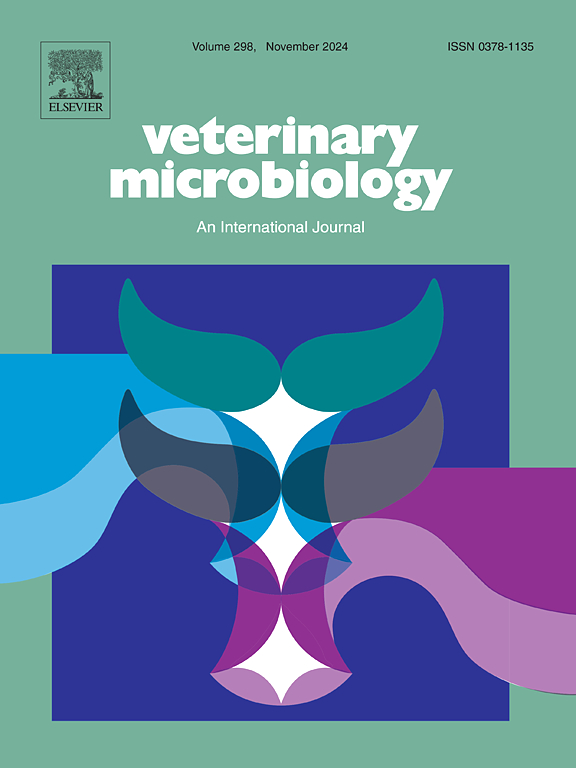西班牙广泛饲养的猪体内戊型肝炎病毒的纵向调查。
IF 2.4
2区 农林科学
Q3 MICROBIOLOGY
引用次数: 0
摘要
戊型肝炎病毒(HEV)是一种新出现的引起公共卫生关注的人畜共患病毒,猪、野猪和梅花鹿是其主要传播者。欧洲食品安全局(EFSA)最近优先考虑在猪食物链的不同阶段(包括户外养猪)制定 HEV 监测计划。在这些粗放型生产系统下管理的猪在育肥阶段经常与野猪和红鹿共享栖息地和自然资源,以前曾有人提出过 HEV 在这些物种间的跨物种传播。在这种情况下,我们的目标是:(I)评估 HEV 在广泛饲养的猪的生产阶段以及在家畜与野生动物交界处传播的风险;(II)确定在这些宿主中传播的基因型。在种猪、育成猪和育肥猪生产阶段,对来自 7 个不同猪场的 1452 头猪进行了纵向采样。此外,还分别对 138 头和 252 头同域野猪和赤鹿进行了分析。在采样的 1452 头伊比利亚猪中,有 1245 头(85.7%)发现了抗 HEV 抗体。血清流行率在育种阶段为 30.4%,在饲养阶段为 95.4%,在育肥阶段为 97.0%。三个生产阶段之间存在明显的统计学差异(P < 0.05)。与同域野猪(31.9 %)和赤鹿(2.0 %)相比,育肥猪的血清流行率明显更高(P < 0.001)。在分析的 293 份血清池中,有 3 份(1.0 %)病毒 RNA 呈阳性。其中一个在饲养阶段的猪(基因型 3 f)中发现,两个在野猪(基因型 3 f 和 3 m)中发现。在广泛饲养的猪中检测到的高血清流行率,以及在同域家猪和野猪中检测到的人畜共患的 HEV-3 f 和 HEV-3 m 亚型,突出表明了人畜共患传播的风险,以及在这些流行病学情况下建立监测计划和控制措施的必要性,特别是在繁殖和饲养阶段。本文章由计算机程序翻译,如有差异,请以英文原文为准。
Longitudinal survey of hepatitis E virus in extensively raised pigs in Spain
Hepatitis E virus (HEV) is an emerging zoonotic virus of public health concern, of which pigs, wild boar and red deer are the main reservoirs. The European Food Safety Authority (EFSA) has recently prioritized the development of monitoring programs of HEV at different stages of the pig food chain, including outdoor pig farming. Pigs managed under these extensive production systems frequently share habitat and natural resources with wild boar and red deer during fattening stages and cross-species transmission of HEV among these species has previously been suggested. In this context, we aimed to (I) to evaluate the risk of HEV circulation within the production phases of extensively raised pigs and at the domestic-wildlife interface, and (II) to identify the genotypes circulating within these hosts. A total of 1452 pigs from seven different pig farms were longitudinally sampled during the breeding, rearing, and fattening production phases. In addition, 138 and 252 sympatric wild boar and red deer, respectively, were analysed. Anti-HEV antibodies were found in 1245 (85.7 %) out of the 1452 Iberian pigs sampled. The seroprevalence was 30.4 % in the breeding phase, 95.4 % in the rearing phase and 97.0 % in the fattening phase. Statistically significant differences (P < 0.05) were found among the three production phases. The seroprevalence was significantly higher (P < 0.001) in fattening pigs compared to those found in sympatric wild boar (31.9 %) and red deer (2.0 %). Three (1.0 %) out of the 293 serum pools analysed were positive for viral RNA. One of them was identified in pigs at the rearing phase (genotype 3 f) and two in wild boar (genotypes 3 f and 3 m). The high seroprevalence detected in extensively raised pigs, together with the detection of the zoonotic HEV-3 f and HEV-3 m subtypes in sympatric domestic and wild swine, highlights the risk of zoonotic transmission and the need to establish surveillance programs and control measures, particularly in breeding and rearing phase, in these epidemiological scenarios.
求助全文
通过发布文献求助,成功后即可免费获取论文全文。
去求助
来源期刊

Veterinary microbiology
农林科学-兽医学
CiteScore
5.90
自引率
6.10%
发文量
221
审稿时长
52 days
期刊介绍:
Veterinary Microbiology is concerned with microbial (bacterial, fungal, viral) diseases of domesticated vertebrate animals (livestock, companion animals, fur-bearing animals, game, poultry, fish) that supply food, other useful products or companionship. In addition, Microbial diseases of wild animals living in captivity, or as members of the feral fauna will also be considered if the infections are of interest because of their interrelation with humans (zoonoses) and/or domestic animals. Studies of antimicrobial resistance are also included, provided that the results represent a substantial advance in knowledge. Authors are strongly encouraged to read - prior to submission - the Editorials (''Scope or cope'' and ''Scope or cope II'') published previously in the journal. The Editors reserve the right to suggest submission to another journal for those papers which they feel would be more appropriate for consideration by that journal.
Original research papers of high quality and novelty on aspects of control, host response, molecular biology, pathogenesis, prevention, and treatment of microbial diseases of animals are published. Papers dealing primarily with immunology, epidemiology, molecular biology and antiviral or microbial agents will only be considered if they demonstrate a clear impact on a disease. Papers focusing solely on diagnostic techniques (such as another PCR protocol or ELISA) will not be published - focus should be on a microorganism and not on a particular technique. Papers only reporting microbial sequences, transcriptomics data, or proteomics data will not be considered unless the results represent a substantial advance in knowledge.
Drug trial papers will be considered if they have general application or significance. Papers on the identification of microorganisms will also be considered, but detailed taxonomic studies do not fall within the scope of the journal. Case reports will not be published, unless they have general application or contain novel aspects. Papers of geographically limited interest, which repeat what had been established elsewhere will not be considered. The readership of the journal is global.
 求助内容:
求助内容: 应助结果提醒方式:
应助结果提醒方式:


